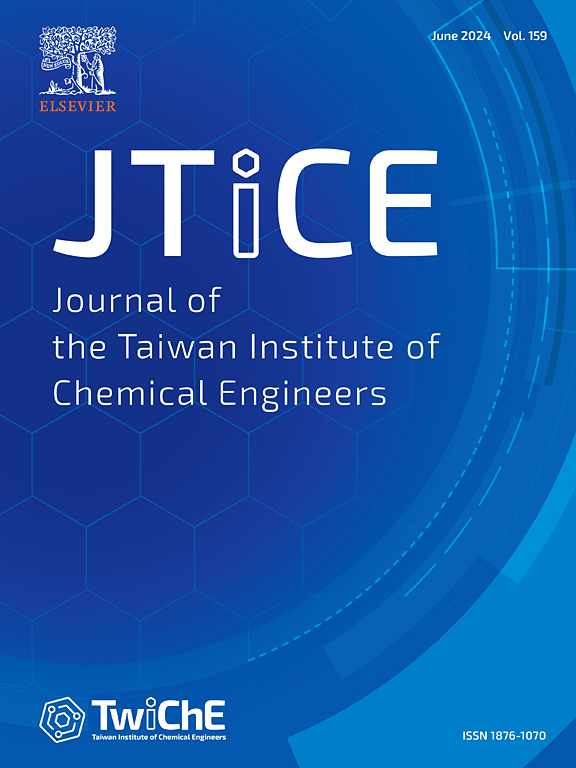Revisiting the softening and melting behavior of sinter under simulated blast furnace conditions: Part I – Thermodynamic and experimental insights on working line
IF 5.5
3区 工程技术
Q1 ENGINEERING, CHEMICAL
Journal of the Taiwan Institute of Chemical Engineers
Pub Date : 2025-02-13
DOI:10.1016/j.jtice.2025.106013
引用次数: 0
Abstract
Background
Due to the complex reaction conditions within the blast furnace (BF), often termed a “black box”, previous research has largely relied on oversimplified experimental setups. This limitation has significantly impeded the accurate investigation of the detailed mechanisms governing the softening and melting (S&M) behaviors of sinter ore. To address these challenges, this study establishes experimental conditions designed to more closely replicate the internal BF environment, guided by the concept of the BF working line.
Methods
A novel Blast Furnace Simulator, equipped with an in-line mass spectrometry (MS) gas analyzer, was employed to replicate the BF conditions with high fidelity. The exhaust gas compositions were continuously monitored and quantified, enabling precise calculations of the indirect, direct, and overall reduction degrees during the experiment.
Significant Findings
A mechanistic understanding of key S&M behaviors, including mechanical softening at 1000 °C, physico-chemical softening at 1150 °C, and the sharp pressure drop accompanied by the collapse of the core-shell structure at 1330 °C, is characterized. The findings underscore the critical role of the core-shell structure in maintaining gas diffusion pathways, which are closely tied to the permeability performance of BF operations. These insights into S&M mechanisms under simulated BF conditions provide a strong foundation for advancing research on hydrogen-enriched BF operations.

烧结矿在模拟高炉条件下的软化和熔化行为:第一部分-生产线上的热力学和实验见解
由于高炉(BF)内复杂的反应条件,通常被称为“黑箱”,以往的研究在很大程度上依赖于过于简化的实验装置。这一限制极大地阻碍了对控制烧结矿软化和熔化(S&;M)行为的详细机制的准确研究。为了解决这些挑战,本研究建立了实验条件,旨在更紧密地复制高炉内部环境,并以高炉工作线的概念为指导。方法采用一种新型的高炉模拟器,配备在线质谱(MS)气体分析仪,高保真地复制高炉的条件。对废气成分进行连续监测和量化,精确计算实验过程中间接、直接和整体的减排程度。关键的S&;M行为,包括1000°C时的机械软化,1150°C时的物理化学软化,以及1330°C时伴随核壳结构崩溃的急剧压降的机理理解。研究结果强调了核心-壳结构在维持气体扩散路径方面的关键作用,这与高炉运行的渗透性能密切相关。这些对模拟高炉条件下S&;M机制的见解为推进富氢高炉操作的研究提供了坚实的基础。
本文章由计算机程序翻译,如有差异,请以英文原文为准。
求助全文
约1分钟内获得全文
求助全文
来源期刊
CiteScore
9.10
自引率
14.00%
发文量
362
审稿时长
35 days
期刊介绍:
Journal of the Taiwan Institute of Chemical Engineers (formerly known as Journal of the Chinese Institute of Chemical Engineers) publishes original works, from fundamental principles to practical applications, in the broad field of chemical engineering with special focus on three aspects: Chemical and Biomolecular Science and Technology, Energy and Environmental Science and Technology, and Materials Science and Technology. Authors should choose for their manuscript an appropriate aspect section and a few related classifications when submitting to the journal online.

 求助内容:
求助内容: 应助结果提醒方式:
应助结果提醒方式:


